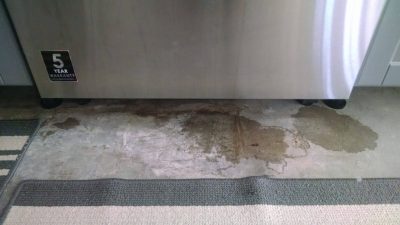Dishwasher leaking water
Most Frequent Causes for Dishwasher leaking:
- The water inlet valve opens to allow water to enter the dishwasher. If the water inlet valve is stuck open, the dishwasher will continue to fill with water until the dishwasher leaks or overflows. If the water inlet valve is at fault, replace it. Water inlet valves are not repairable—if the valve is defective, you must replace it.
- If the wash arm is cracked, it can allow a jet of water to spray toward the door seal, causing a leak. Remove the wash arm and inspect it for cracks. If the wash arm is cracked, replace it. Do not attempt to seal the crack with glue—the glue will break down in the dishwasher. If the wash arm is intact, make sure the screws in the wash arm support are tight. If the wash arm support is loose, water can spray out between the wash arm support and the lower pump housing, causing waves. These waves can cause water to leak out of the bottom of the door.
- If the wash arm is cracked, it can force water to spray directly toward the lower part of the dishwasher door. The water can then be forced under the door and onto the floor, causing a leak. Remove the wash arm and inspect it for cracks. If the wash arm is cracked, replace it. Do not attempt to seal the crack with glue—the glue will break down in the dishwasher. If the wash arm is intact, make sure the screws in the wash arm support are tight. If the wash arm support is loose, water can spray out between the wash arm support and the lower pump housing, causing waves. These waves can cause water to leak out of the bottom of the door.
- If the upper wash arm is cracked, it can force water to spray directly toward the dishwasher door seal, causing a leak. Remove the wash arm and inspect it for cracks. If the wash arm is cracked, replace it. Do not attempt to seal the crack with glue—the glue will break down in the dishwasher. If the wash arm is intact, make sure the screws in the wash arm support are tight. If the wash arm support is loose, water can spray out between the wash arm support and the lower pump housing, causing waves. These waves can cause water to leak out of the bottom of the door.
- Look for tears, gaps or cuts in the seal that could cause a dishwasher door leak. To determine if the door seal is making good contact, try closing the dishwasher door on a dollar bill all the way around the door. If the dollar bill does not stick, there is a gap in the seal. If the door seal has any gaps or leaks, replace it. If the door seal is working properly but the dishwasher is still leaking, check the door hinges. If the hinges are bent, the door will not close properly, creating a gap between the door seal and the dishwasher. If the hinges are bent, replace them.
- Look for tears, gaps or cuts in the gasket that could cause a dishwasher door leak. To determine if the door gasket is making good contact, try closing the dishwasher door on a dollar bill all the way around the door. If the dollar bill does not stick, there is a gap in the gasket. If the door gasket has any gaps or leaks, replace it. If the door gasket is working properly but the dishwasher is still leaking, check the door hinges. If the hinges are bent, the door will not close properly, creating a gap between the door gasket and the dishwasher. If the hinges are bent, replace them.
Fuse HVAC, Refrigeration, Electrical & Plumbing will restore your dishwasher.
Appliance Repair in San Jose, California



